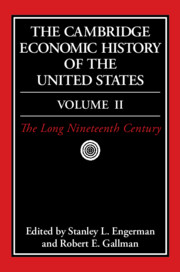Book contents
- Frontmatter
- 1 Economic Growth and Structural Change in the Long Nineteenth Century
- 2 The Economy of Canada in the Nineteenth Century
- 3 Inequality in the Nineteenth Century
- 4 The Population of the United States, 1790–1920
- 5 The Labor Force in the Nineteenth Century
- 6 The Farm, The Farmer, and The Market
- 7 Northern Agriculture and the Westward Movement
- 8 Slavery and its Consequences for the South in the Nineteenth Century
- 9 Technology and Industrialization, 1790–1914
- 10 Entrepreneurship, Business Organization, and Economic Concentration
- 11 Business Law and American Economic History
- 12 Experimental Federalism: the Economics of American Government, 1789–1914
- 13 Internal Transportation in the Nineteenth and Early Twentieth Centuries
- 14 Banking and Finance, 1789–1914
- 15 U.S. Foreign Trade and the Balance of Payments, 1800–1913
- 16 International Capital Movements, Domestic Capital Markets, and American Economic Growth, 1820–1914
- 17 The Social Implications of U.S. Economic Development
- Bibliographic Essays
- Index
- References
16 - International Capital Movements, Domestic Capital Markets, and American Economic Growth, 1820–1914
Published online by Cambridge University Press: 28 March 2008
- Frontmatter
- 1 Economic Growth and Structural Change in the Long Nineteenth Century
- 2 The Economy of Canada in the Nineteenth Century
- 3 Inequality in the Nineteenth Century
- 4 The Population of the United States, 1790–1920
- 5 The Labor Force in the Nineteenth Century
- 6 The Farm, The Farmer, and The Market
- 7 Northern Agriculture and the Westward Movement
- 8 Slavery and its Consequences for the South in the Nineteenth Century
- 9 Technology and Industrialization, 1790–1914
- 10 Entrepreneurship, Business Organization, and Economic Concentration
- 11 Business Law and American Economic History
- 12 Experimental Federalism: the Economics of American Government, 1789–1914
- 13 Internal Transportation in the Nineteenth and Early Twentieth Centuries
- 14 Banking and Finance, 1789–1914
- 15 U.S. Foreign Trade and the Balance of Payments, 1800–1913
- 16 International Capital Movements, Domestic Capital Markets, and American Economic Growth, 1820–1914
- 17 The Social Implications of U.S. Economic Development
- Bibliographic Essays
- Index
- References
Summary
INTRODUCTION
For almost three-quarters of a century, from the end of World War I until the early 1980s, the United States was the world’s largest capital exporter. In the last decade of the previous century, Americans had begun to finance economic activity in Canada and Mexico; until recently these transfers grew and their geographic focus broadened. Over the past decade, however, the world’s largest creditor has become its largest debtor.
Before 1914, however, it was Europe who acted as the world’s banker; and within that continent, it was Britain who was the senior partner. Moreover, over the course of the nineteenth century, it was the United States that received the lion’s share of Europe’s foreign investment. Unlike their great grandchildren, nineteenth-century Americans displayed a high propensity to save. Although the evidence for the early years is sketchy, the share of net capital formation in net national product appears to have averaged about 6.5 percent in the years between 1805 and 1840 and to have risen to almost 20 percent by the end of the century; and most of the resources that were diverted from consumption were domestic not foreign.
- Type
- Chapter
- Information
- The Cambridge Economic History of the United States , pp. 733 - 812Publisher: Cambridge University PressPrint publication year: 2000
References
- 11
- Cited by



